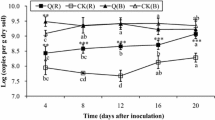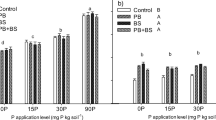Summary
Potential denitrifying activity and population dynamics of Azospirillum lipoferum (137C) and Bradyrhizobium japonicum (G2sp) inoculated into a γ-sterilized soil were studied for a period of 3 weeks. The denitrifying enzyme potential of soil inoculated independently with each bacterial species was strongly stimulated by the presence of a plant (Zea mays L.). Simultaneous inoculation of both bacteria also produced a higher denitrifying enzyme potential than simple inoculation. Even with double inoculation, the presence of a plant did not modify the evolution of the activity. The response of the population dynamics to these treatments followed a different pattern. The population dynamics of A. lipoferum was not affected by the presence of the plant or by the presence of B. japonicum. In contrast, the presence of both a plant and of A. lipoferum seemed to promote the growth of B. japonicum.
Similar content being viewed by others
References
Abou Seada MNI Ottow JCG (1985) Effect of increasing oxygen concentration on total denitrification and nitrous oxide released from soil by different bacteria. Biol Fertil Soils 1:31–38
Alexander M (1981) Why microbial predators and parasites do not eliminate their prey and host. Annu Rev Microbiol 35:113–133
Bailey LD (1976) Effects of temperature and roots on denitrification in a soil. Can J Soil Sci 56:79–87
Baldani VLD Baldani JL Döbereiner J (1987) Inoculation of field grown wheat (Triticum aestivum) with Azospirillum spp. in Brazil. Biol Fertil Soils 4:37–40
Bezdicek DF Donaldson MD (1980) Flocculation of Rhizobium from the soil colloids for enumeration by immunofluorescence. In: Berkeley RCW, Lynch JM, Melling JM, Rutter PR, Vincent B (eds) Microbial adhesion to surfaces. Ellis Horwood, Chichester, pp 297–309
Cleyet Marel JC, Crozat Y (1982) Etude écologique en immunofluorescence de Rhizobium japonicum dans le sol et la rhizosphère. Agron 2:243–248
Foster RC, Bowen GD (1982) Plant surfaces and bacterial growth: The rhizosphere and rhizoplane. Phytopath Prokar 1:159–185
Gamard P, Laguerre G, Bardin R (1987) Dénombrement d'Azospirillum lipoferum dans le sol et la rhizosphère par la méthode des anticorps fluorescents. Rev Ecol Biol Sol 24:389–402
Garcia JL (1975) Effet rhizosphère du riz sur la dénitrification. Soil Biol Biochem 7:139–141
Haider K, Mosier A, Heinmeyer O (1987) The effect of growing plants on denitrification at high soil nitrates concentration. Soil Sci Soc Am J 51:97–102
Hogdson ALM, Stacey G (1986) Potential for Rhizobium improvement. CRC Critical Rev Biotechnol 4:1–74
Hureck T, Reinhold B, Fendrik I, Niedmann EG (1987) Root zone specific oxygen tolerance of Azospirillum spp. and diazotrophic rod closely associated with kallar grass. Appl Environ Microbiol 53:163–169
Jackson NE, Corey JC, Frederick LR, Picken JC (1967) Gamma irradiation and the microbial populations of soils at two water contents. Soil Sci Soc Am Proc 31:491–494
Jenkinson DS, Powlson DS (1976) The effects of biocidal treatments on metabolism in soil: A method for measuring soil biomass. Soil Biol Biochem 8:209–213
Lensi R, Chalamet A (1982) Denitrification in waterlogged soils: In situ temperature-dependant variations. Soil Biol Biochem 14:51–55
Mandimba G, Heulin T, Bally R, Guckert A, Balandreau J (1986) Chemotaxis of the free living nitrogen fixing bacteria toward maize mucilage. Plant and Soil 90:129–139
Neyra CA, Van Berkum P (1977) Nitrate reduction and nitrogenase activity in Spirillum lipoferum. Can J Microbiol 23:306–310
O'Hara GW, Daniel RM (1985) Rhizobial denitrification: A review. Soil Biol Biochem 17:1–9
Okon Y (1985) Azospirillum as a potential inoculant for agriculture. Trends Biotechnol 3:223–228
Payne WJ (1981) Denitrification. Wiley, New York
Plazinski J, Rolfe BG (1985a) Influence of Azospirillum strains on the nodulation of clovers by Rhizobium strains. Appl Environ Microbiol 49:984–989
Plazinski J, Rolfe BG (1985b) Interaction of Azospirillum and Rhizobium strains leading to inhibition of nodulation. Appl Environ Microbiol 49:990–993
Ramsay AJ, Bawden AD (1983) Effects of sterilization and storage on respiration, nitrogen status and direct counts of soil bacteria using acridine orange. Soil Biol Biochem 15:263–268
Scaglia JA, Lensi R, Chalamet A (1985) Relationship between photosynthesis and denitrification in planted soil. Plant and Soil 84:37–43
Schmidt EL (1974) Quantitative autecological study of microorganisms in soil by immunofluorescence. Soil Sci 118:141–149
Smith MS, Tiedje JM (1979) Phases of denitrification following oxygen depletion in soil. Soil Biol Biochem 11:261–267
Stacey G, Upchurch RG (1984) Rhizobium inoculation of legumes. Trends Biotechnol 2:65–69
Steinberg C, Faurie G, Zegerman M, Pave A (1987) Regulation par les protozoaires d'une population bactérienne introduite dans le sol: Modélisation mathématique de la relation prédatorr-proie. Rev Ecol Biol Sol 24:49–62
Tiedje JM, Sextone AJ, Myrold DD, Robinson JA (1982) Denitrification: Ecological niches, competition and survival. Antonie Van Loeuwenhoek 48:569–583
Vidor C, Miller RH (1980) Relative saprophytic competence of Rhizobium japonicum strains in soils as determined by the quantitative fluorescent antibody (FA) technique. Soil Biol Biochem 12:483–487
Vincent JM (1970) A manual for the practical study of the root nodule bacteria. Blackwell, Oxford
Yahalom E, Okon Y, Dovrat A (1987) Azospirillum effects on susceptibility to Rhizobium nodulation and on nitrogen fixation of several forage legumes. Can J Microbiol 33:510–514
Yoshinari T, Hynes R, Knowles R (1977) Acetylene inhibition of nitrous oxide reduction and measurements of denitrification and nitrogen fixation in soil. Soil Biol Biochem 9:177–183
Author information
Authors and Affiliations
Rights and permissions
About this article
Cite this article
Steinberg, C., Gamard, P., Faurie, G. et al. Survival and potential denitrifying activity of Azospirillum lipoferum and Bradyrhizobium japonicum inoculated into sterilized soil. Biol Fert Soils 7, 101–107 (1989). https://doi.org/10.1007/BF00292566
Received:
Issue Date:
DOI: https://doi.org/10.1007/BF00292566




